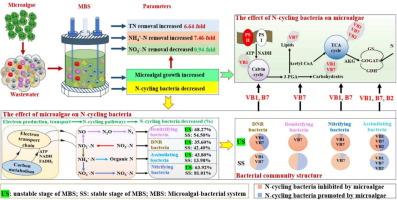再论微藻和氮循环细菌双重代谢对共同去除氮的协同机制
IF 13.3
1区 工程技术
Q1 ENGINEERING, CHEMICAL
引用次数: 0
摘要
本文章由计算机程序翻译,如有差异,请以英文原文为准。

Re-discussing the synergistic mechanisms in dual metabolism of microalgae and N-cycling bacteria on joint N removal
Nitrogen (N) removal in microalgal-bacterial system (MBS) depends on the dual metabolism of microalgae and N-cycling bacteria. However, the effect of specific synergistic mechanisms involved in the dual metabolism on N removal remains unclear. Here, N removal performance, community compositions, N-cycling related metabolism, and biosynthesis and transport of cofactors were explored to clarify the synergistic mechanism between microalgae and N-cycling bacteria. Results indicated that microalgae hindered the N removal capability of dissimilatory nitrate reducing (DNR) bacteria, denitrifying bacteria, nitrifying bacteria, and assimilating bacteria by suppressing the electron transport chain of N-cycling bacteria. Fortunately, although the N removal ability of N-cycling bacteria decreased, the N-cycling bacterial community collaborative mode among multiple N-cycling pathways could drive microalgal growth and assimilation via providing the essential vitamins B1, B2, and B7, thus enhancing the synergistic effects of microalgae and N-cycling bacteria on N removal. Compared with the control, the removal efficiencies of TN and NH4+-N in MBS increased by 6.64-fold and 7.46-fold. Meanwhile, microalgal growth and chlorophyll a increased by 1.53-fold and 1.52-fold in MBS. But, the NO3–-N removal efficiency decreased by 0.94-fold in MBS, the abundance of denitrifying bacteria was higher than DNR bacteria in MBS, suggesting that NO3–-N removal capacity in MBS was predominantly associated with denitrifying bacteria, while microalgae exhibit a tendency to prefer absorbing NH4+-N rather than NO3–-N. Together, this work improves our understanding of N removal mechanisms in MBS and provides valuable insights for the effective design and operation of MBS in real wastewater.
求助全文
通过发布文献求助,成功后即可免费获取论文全文。
去求助
来源期刊

Chemical Engineering Journal
工程技术-工程:化工
CiteScore
21.70
自引率
9.30%
发文量
6781
审稿时长
2.4 months
期刊介绍:
The Chemical Engineering Journal is an international research journal that invites contributions of original and novel fundamental research. It aims to provide an international platform for presenting original fundamental research, interpretative reviews, and discussions on new developments in chemical engineering. The journal welcomes papers that describe novel theory and its practical application, as well as those that demonstrate the transfer of techniques from other disciplines. It also welcomes reports on carefully conducted experimental work that is soundly interpreted. The main focus of the journal is on original and rigorous research results that have broad significance. The Catalysis section within the Chemical Engineering Journal focuses specifically on Experimental and Theoretical studies in the fields of heterogeneous catalysis, molecular catalysis, and biocatalysis. These studies have industrial impact on various sectors such as chemicals, energy, materials, foods, healthcare, and environmental protection.
 求助内容:
求助内容: 应助结果提醒方式:
应助结果提醒方式:


